Imagine a material that possesses the strength of aluminum, the lightness of plastic, and an extraordinary resistance to heat and chemicals. This isn’t a hypothetical material. It’s Polyetheretherketone (PEEK), a high-performance thermoplastic that’s transforming how we approach design and manufacturing challenges across various sectors.
For one Multiscale Systems project sponsored by NASA, we were tasked with designing a component that could survive the punishing environment of space. We turned to PEEK as our material of choice and not only did it withstand the rigorous testing simulations, it outperformed alternatives by being lighter, more durable, and resistant to extreme temperatures.
This example is just one way we’re harnessing the unique properties of PEEK to provide innovative solutions to tough challenges in design and engineering, including those sponsored by prominent organizations such as NASA and the Department of Energy.
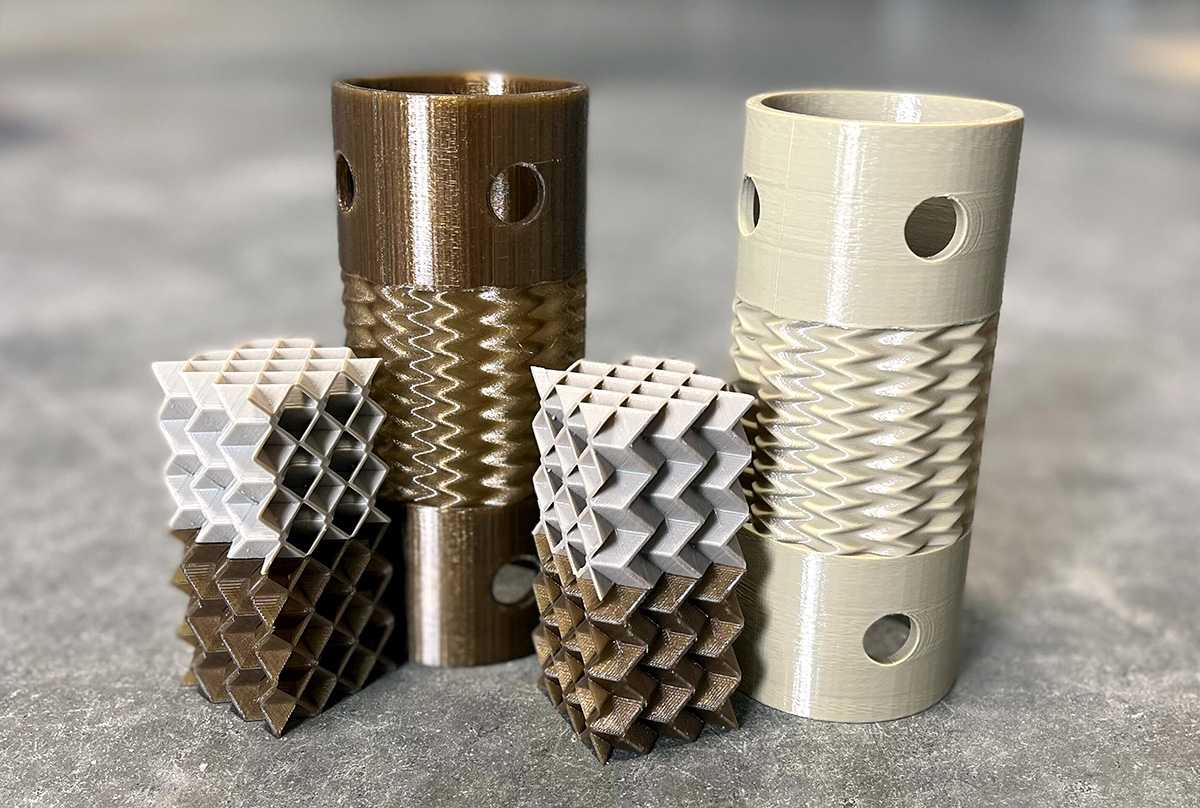
The development of PEEK and related polymers
The advent of PEEK and its high-performance polymer family, Polyaryletherketones (PAEKs), represents a significant milestone in materials science. Dating back to its initial synthesis by the UK-based Imperial Chemical Industries (ICI) in the late 1970s, PEEK, along with its cousin PEKK (Polyetherketoneketone), marked a significant breakthrough in the world of engineering materials.
The development journey of PEEK was not without its challenges. The ICI research team, led by Dr. Raymond W. Bonnett, sought to create a material that could withstand extreme conditions in a way similar to metals, but at a fraction of the weight. Balancing the intricate chemical structures to yield the desired properties took years of relentless effort.
Finally, when PEEK was successfully synthesized, it was nothing less than a revolution in material science. Here was a polymer that delivered the mechanical strength and thermal stability akin to metals but with significantly reduced weight. This breakthrough ushered in a new era in high-performance materials, offering novel possibilities in various fields from aerospace to medicine. Today, PEEK continues to be a material of choice for demanding applications, a testament to the vision and perseverance of its creators.
The unique properties of PEEK
PEEK is remarkable in its ability to maintain a balance of mechanical, thermal, and chemical properties over a wide temperature range, performing well up to 250°C (482°F). But what does that mean exactly?
When we talk about mechanical properties, we’re referring to how a material reacts under various forces. For instance, tensile strength is a measure of how much pulling, or tension, a material can withstand before breaking. It’s similar to playing tug-of-war: a high tensile strength means the material can handle a lot of pulling without snapping.
Thermal properties, on the other hand, are about how a material behaves in response to changes in temperature and are crucial for materials used in environments with extreme heat or cold. PEEK can retain its structure and performance even when exposed to very high heat.
Chemical properties refer to how a material interacts with different chemicals it may encounter. PEEK shines in this aspect due to its unique molecular structure. Its polymer chains contain rings, ethers, and ketones, which are highly stable and resistant to attack by a broad range of chemicals. Aromatic rings, with their cyclic structure and shared electrons, provide stability and strength. Ethers, meanwhile, offer flexibility without compromising durability. Ketones contribute to high-temperature stability. This unique combination of molecular components makes PEEK highly resistant to many corrosive chemicals.
The following data tables provide the specifics of these properties for PEEK, giving a sense of how this material performs under various conditions.
Typical mechanical properties
| Property | Value |
|---|---|
| Tensile strength | 90-100 MPa |
| Flexural strength | 150-163 MPa |
| Elongation at break | 50% |
Typical thermal properties
| Property | Value |
|---|---|
| Melting point | 343°C |
| Continuous service temperature | Up to 250°C |
Environmental resistance
| Property | Value |
|---|---|
| Chemical resistance | Excellent against a wide range of organic and inorganic substances |
| Dielectric strength | 19.7 kV/mm |
3D printing with PEEK
The advent of 3D printing has opened a new avenue for PEEK processing, expanding the possibilities of its applications. However, just like any other manufacturing process, 3D printing PEEK has its advantages, disadvantages, and potential risks.
One of the greatest strengths of 3D printing lies in its ability to create complex geometries and custom parts that would be challenging or impossible to produce using traditional manufacturing techniques. This advantage, coupled with its potential for rapid prototyping and on-demand production, makes 3D printing a promising technique for PEEK processing.
However, 3D printing PEEK is not without its challenges. The material’s high processing temperature requires specialized equipment to manage, and the risk of warping or shrinkage during cooling necessitates careful control of the printing environment. These factors can contribute to a steeper learning curve and higher initial costs compared to traditional techniques.
Despite these challenges, the opportunities presented by 3D printing PEEK are significant. As additive manufacturing technology continues to advance, it’s likely that we’ll see more sophisticated solutions to manage the printing process, making PEEK even more accessible for a wider range of applications.
Multiscale Systems’ 3DGence Industry F350 high-temperature printer producing a PEEK cylinder.
When we compare 3D printing with traditional methods such as machining, extrusion, and milling, the differences become more apparent. Machining and milling provide high precision and can produce large PEEK parts with excellent dimensional stability. However, these methods can be costly, particularly for low-volume production, and they generate waste material.
Extrusion, on the other hand, is a cost-effective technique for mass producing simple shapes like rods, tubes, and sheets, but it struggles with complex geometries.
While 3D printing PEEK presents its own set of challenges, it also offers unique advantages that align well with the growing demand for customization, complexity, and rapid prototyping in modern manufacturing. 3D printing, with its ability to handle complexity with ease, fills this gap and offers a complementary solution.
Comparative analysis of PEEK with other materials
In many applications, PEEK successfully substitutes metals and other polymers due to its unique property profile. But what specifically makes PEEK superior to these materials? Let’s delve into this question by comparing PEEK with other commonly used materials.
When it comes to chemical resistance, PEEK outperforms aluminum. While aluminum is an excellent material for various applications, it can corrode when exposed to certain chemicals, especially strong acids or bases. But PEEK’s unique molecular structure equips it with superior chemical resistance. It can withstand a broad range of chemicals, making it a preferred choice for environments where exposure to corrosive substances is a concern.
Similarly, compared to other polymers like PEI and Nylon, PEEK offers superior thermal stability. PEI and Nylon, although versatile materials, can degrade or lose their mechanical properties when exposed to high temperatures. However, PEEK retains its mechanical strength and dimensional stability even at elevated temperatures, making it an ideal material for applications in extreme thermal conditions.
These factors, combined with its excellent mechanical properties and light weight, make PEEK a preferred material over others in many challenging applications. The following table summarizes a few key properties of PEEK and PEKK (members of the PAEK family) alongside other more commonly known materials for reference:
| Materials | Tensile strength (MPa) | Maximum continuous service temperature (°C) | Density (g/cm3) | Chemical resistance |
|---|---|---|---|---|
| PEEK | 90-100 | 250 | 1.3 | Excellent |
| PEKK | 95-105 | 260 | 1.27 | Excellent |
| PEI | 70-80 | 170 | 1.27-1.28 | Excellent |
| Polypropylene | 25-35 | 100 | 0.9 | Good to Excellent |
| Polyethylene | 20-30 | 80 | 0.92-0.96 | Good to Excellent |
| PA6 (Nylon) | 45-80 | 100 | 1.13-1.15 | Good |
| Aluminum Alloy 6061 | 310 | 400 | 2.7 | Good |
| 316L Stainless Steel | 485 | 870 | 8 | Excellent |
Values in this table are “typical” and can be modified with the use of additives, fillers, and other processing strategies.
Annealing and its impact on PEEK’s properties
After 3D printing, PEEK parts often undergo a process called annealing to further enhance their mechanical and thermal properties.
Annealing is a heat treatment process in which the 3D printed part is heated to a specific temperature, held there for a certain period, and then gradually cooled down. This treatment isn’t just a simple heating and cooling routine, but a transformative process at the molecular level.
In the case of PEEK, when the material is heated during annealing, the polymer chains gain enough energy to move and rearrange themselves. This rearrangement allows the chains to pack more closely together and align better, reducing internal stresses and improving the crystallinity of the material. The result is a significant enhancement in mechanical strength and thermal stability.
By controlling the annealing process, we can optimize these properties to match the specific requirements of a given application. This ability to fine tune PEEK’s properties post-printing adds another layer to its versatility, further solidifying its position as an indispensable material in high-performance applications.
| Property | As-printed PEEK | Annealed PEEK |
|---|---|---|
| Tensile strength (MPa) | 90-100 | 95-105 |
| Flexural strength (MPa) | 150-163 | 155-165 |
| Maximum continuous service temperature (°C) | 250 | 280 |
Values in this table are “typical”.
PEEK MetaCORE®
At Multiscale Systems, we’re constantly working to enhance the offerings of our metamaterial composite portfolio. This line of advanced materials uses a complicated 3D origami-inspired geometry to achieve exotic mechanical properties. See Working with MetaCORE (PDF) for a deep dive.
When it comes to fabricating MetaCORE by 3D printing PEEK, we have a unique opportunity to further engineer material properties through geometry while retaining the chemical and thermal properties of the underlying polymer structure.
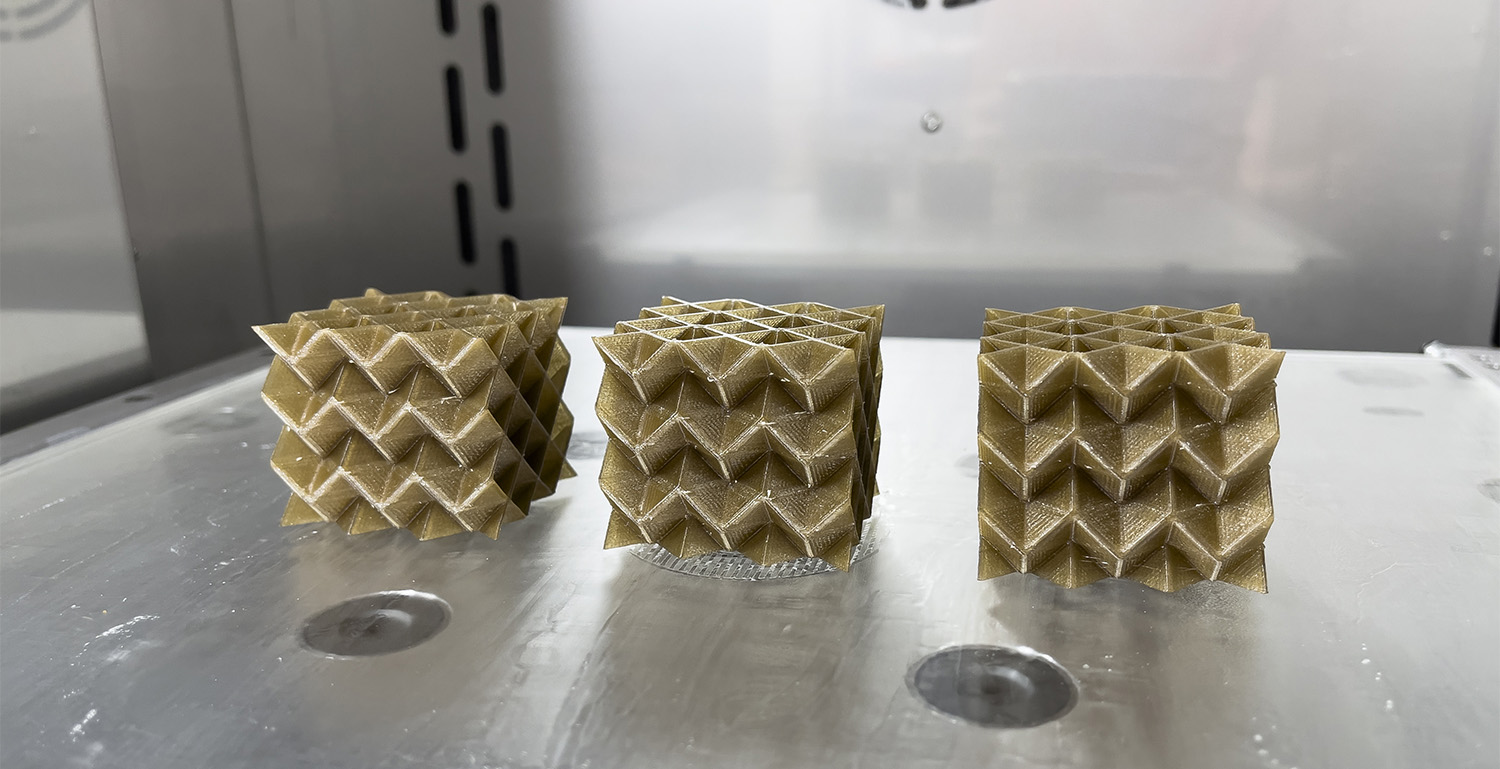 MetaCORE cubes made of of PEEK sit within the high-temperature 3D printer.
MetaCORE cubes made of of PEEK sit within the high-temperature 3D printer.
Qualifying PEEK
The following data show the results of destructive tests where various PEEK MetaCORE samples were crushed in our Instron mechanical tester. Each printed part has three distinct orientations. Replicates were made to destructively test each orientation. The data show a stress-strain curve consistent with what we’ve come to expect from MetaCORE through extensive testing.
A set of replicates were subsequently 3D printed and annealed to evaluate the effectiveness of this chemical transformation. Interestingly, the annealing process enhances the thermal resilience, but reduces the ductility. As a result, the non-linear stress-strain curve went from the “typical” MetaCORE shape to one that had more brittle characteristics.
Data in the following table shows how the post-crush “plateau” of constant stress in as-printed PEEK is replaced by a brittle collapse of load-bearing abilities in the annealed PEEK. These types of trade-offs are important to identify and leverage into our design and engineering processes.
| As-printed | Annealed | |
|---|---|---|
| Crush-X | 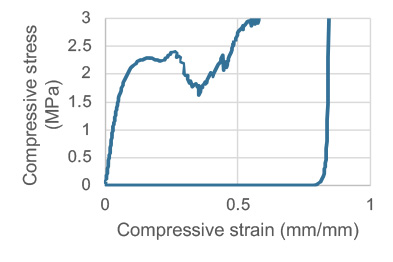 |
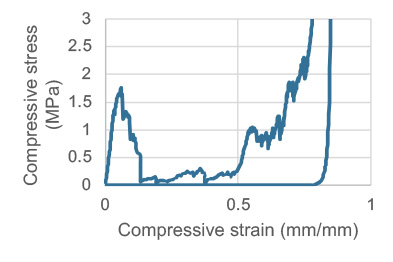 |
| Crush-Y | 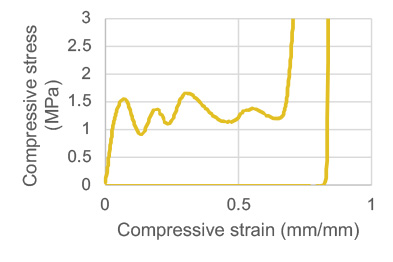 |
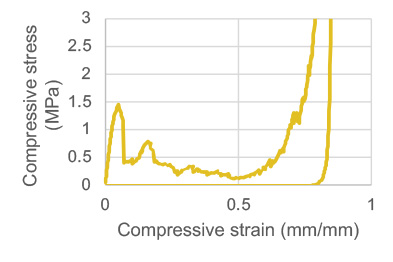 |
| Crush-Z | 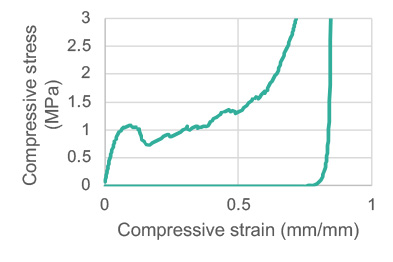 |
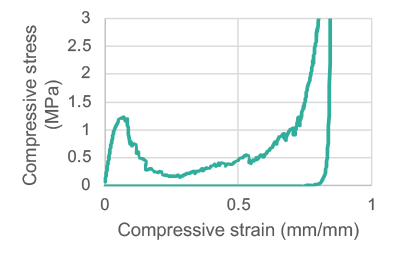 |
PEEK applications: Solving industry-specific challenges
PEEK’s versatility has made it an attractive choice across a range of sectors. However, as we delve into how PEEK aligns with the demands of different industries and addresses their specific challenges, it’s crucial to understand that like any material, it has its limitations and may not be the optimal choice for every situation.
Energy
PEEK’s superior mechanical properties, heat resistance, and chemical inertness make it ideal for demanding applications in the energy sector. However, for extremely high-pressure scenarios or environments with unique chemical combinations, specialized materials might be required.
Examples of how PEEK could be used in energy applications:
- Downhole tools: High-pressure and high-temperature conditions are the norms in oil and gas exploration. PEEK’s robustness under these conditions makes it an excellent material for downhole tools.
- Seals and gaskets: With exceptional chemical resistance, PEEK is beneficial for seals and gaskets that must withstand exposure to aggressive chemicals.
- Insulators: Electrical insulators made from PEEK offer high dielectric strength and thermal stability, making them essential for high voltage applications.
Aerospace
The aerospace industry values PEEK for its light weight, strength, and resistance to environmental factors. Strict regulations and performance requirements in this sector may necessitate further testing or material modification.
Examples of how PEEK could be used in aerospace:
- Aircraft brackets: PEEK is used to make aircraft brackets that are lightweight and corrosion-resistant, leading to lower maintenance costs and improved fuel efficiency.
- Wiring insulation: With excellent dielectric properties and flame resistance, PEEK is ideal for wire insulation in aircraft electrical systems.
- Engine components: The high heat resistance and mechanical strength of PEEK make it a suitable material for various engine components.
Medical
In the medical industry, PEEK’s biocompatibility, sterilizability, and radiolucency align perfectly with industry needs, though its relatively high cost compared to some other plastics might be a consideration.
Examples of how PEEK could be used in the medical industry:
- Spinal fusion cages: PEEK is used to create spinal fusion cages that offer better stress distribution and improved visibility during post-operative imaging.
- Sterilization trays: With resistance to various sterilization methods, PEEK is a preferred material for sterilization trays.
- Medical device components: Various medical device components, such as gears in a surgical robot, benefit from PEEK’s strength and biocompatibility.
Manufacturing
Efficiency, versatility, and the ability to handle complex geometries are key in the manufacturing industry. But PEEK’s higher cost and the need for specialized equipment for processing can be limiting factors.
- Custom gears: With the capability to fabricate complex geometries and parts, PEEK allows for the production of custom gears that are lightweight, resistant to wear, and capable of handling high precision requirements.
- Bearings: PEEK’s excellent wear resistance and self-lubricating properties make it ideal for bearings, reducing the need for maintenance.
- Lightweight structural components: PEEK has a high strength-to-weight ratio, making it ideal for producing lightweight structural components.
While PEEK provides a broad range of benefits in diverse applications, understanding the trade-offs and limitations of using PEEK is essential in making informed material selection decisions. At Multiscale Systems, we pride ourselves on a deep understanding of these factors, allowing us to guide our partners towards the best solutions for their specific needs.
Get started with PEEK
PEEK has undoubtedly emerged as a game-changer in the realm of high-performance polymers, boasting a unique amalgamation of mechanical, thermal, and chemical properties.
At Multiscale Systems, we have not only embraced the potential of PEEK but also evolved to master its intricacies. Our intimate knowledge of PEEK, our advanced 3D printing capabilities, and our dedication to innovation enables us to work collaboratively with our partners and clients to understand their unique challenges and to devise bespoke, effective solutions.
If the possibilities of PEEK pique your interest, and you’re curious about exploring its potential benefits for your applications, we invite you to contact us. Our team of experts is ready to discuss your specific needs and explore how our groundbreaking engineering solutions can help you reach your objectives.
Related Posts
Latest Lab Notes

Press Release /
WORCESTER, Mass. (July 12, 2024) – Multiscale Systems to build new facilities, expand advanced manufacturing capabilities, and bring jobs to Worcester with grant investment.

News /
Multiscale Systems moves on as a finalist in the Department of Energy's Heliostat Prize.
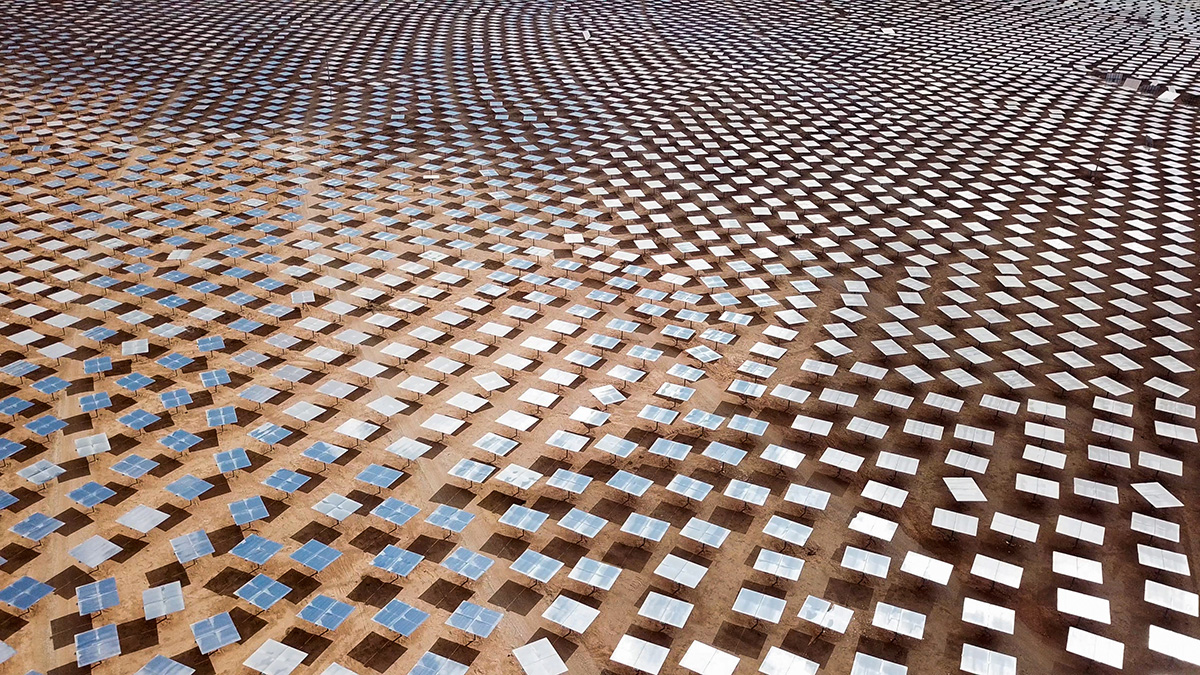
Press Release /
WORCESTER, Mass. (November 20, 2023) – The U.S. Department of Energy has announced Multiscale Systems as one of nine semifinalists in their American-Made Heliostat Prize. The prize is designed to accelerate technology innovation of selected heliostat components.


 Jesse Silverberg, Ph.D. is the CEO and Research Director at Multiscale Systems. With a background in science, writing, and public speaking, Jesse now leads Multiscale Systems toward sustainable commercial success.
Jesse Silverberg, Ph.D. is the CEO and Research Director at Multiscale Systems. With a background in science, writing, and public speaking, Jesse now leads Multiscale Systems toward sustainable commercial success.